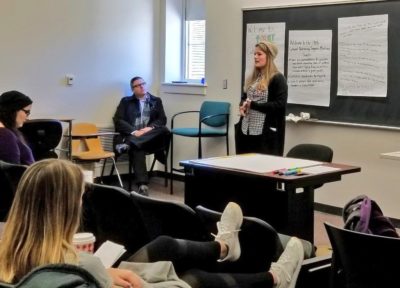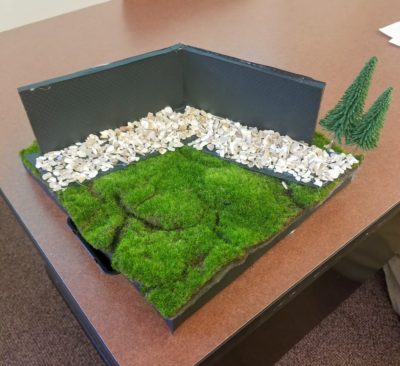Sneaking public history into general education courses
16 July 2019 – Katie Stringer Clary

Students debating cultural patrimony compromises for Native Americans in a Reacting To The Past game. Photo credit: Katie Stringer Clary.
After moving to a new state and leaving a position as Executive Director of Blount Mansion, a historic house museum, I joined the academic world as an adjunct teaching associate in the history department at Coastal Carolina University in Conway, South Carolina. The department wanted to add public history to their repertoire, so I was happy to fill that gap. My background is in museums, and my Ph.D. is in public history, so I fit the bill. It was a cost-effective investment to have a contingent faculty member introduce the field to students. In 2018 I was hired as an Assistant Professor of History, Public History.
While I teach courses on public history specifically, I also teach general education classes. These classes sometimes have a history major or two, but usually the demographics include business, marine science, education, arts, and everything in between. As a medium-sized state school, our students are approximately 50% in-state and 50% out-of-state or international. In these core courses, instructors have the opportunity to capture the attention of students who may otherwise have no interest in history at all. Public history and the use of museum learning techniques are a great hook with which to inspire and engage students in the field.
In HIST105: Pre-Modern World, instructors may choose their own subtitles, content, books, and themes. Rather than try to tackle all of human history to 1500 CE, my courses generally focus on major themes in world history and include public history projects and assignments throughout. I assign a more traditional research paper on what public history is and why the field is important. We also use material culture in museum collections to learn about cultures, and I sometimes use a UNESCO World Heritage group grant project I adapted from a conference session at NCPH in 2016 to instill views of historic preservation, cultural heritage, and historical importance.[1]
The biggest challenge I have faced bringing public history into general education classes is explaining exactly what public history is. I see this as a wonderful opportunity for students to create their own definitions throughout the semester. I begin the classes with a discussion of the NCPH’s “What Is Public History” page and include definitions from my friends in the field. Students then write a short research paper in which they explore different definitions they find online and, in the end, create their own definition.
We revisit this research paper at the end of the semester to see how their ideas and definitions have shifted. This assignment hits the core requirements of research and critical thinking for a traditional history class, but it also teaches students the basics of public history theory and methodology. This course still feels like a traditional history course in many ways, but students come away with an understanding of the field and the value of the principles of public history, and they come to see history as a living, dynamic, and interesting field.
In Spring 2019, a new course, HIST255: Great Debates, seemed the perfect place to try an immersive pedagogy called Reacting to the Past (RTTP).[2] RTTP places students in historical events as historical figures, to see how people make decisions, how precarious events that made history really were, and to build empathy with people from the past. Reacting flips the classroom, with the instructor sitting in the back to provide help. Students make speeches, debate, hold demonstrations, and make all the hard decisions.

A diorama submitted by a student for extra credit in Vietnam War Memorial simulation. Photo credit: Katie Stringer Clary.
For HIST255, I built a class based on debates in Public History. The course was made up of 22 students from all backgrounds and majors. We ran 5 Reacting games over the semester. Among other topics, the class reacted to—and debated—the memorialization of the Vietnam War in 1980, the “Ground Zero Mosque” in New York City in 2009, cultural patrimony of Native American artifacts and remains in 1988, and various repatriation cases at museums around the world. The methodologies of Reacting are such that students often do more research and are more engaged in the material because there is the extra carrot of “winning” the game.
The most affecting event that we had in the HIST255 course was a visit from a local community member, Chief Harold Hatcher of the Waccamaw people. Chief Hatcher spoke to the class after we had our debate on cultural patrimony and the Native American Graves Protection and Repatriation Act as someone who has been personally impacted by the decisions made by the government and stakeholders in 1990. His talking with students and answering questions drove home the importance of working with communities, listening, and employing empathy.
Even in courses with 40 to 100 students it is possible to incorporate public history. As an adjunct, I taught 120 students a semester with the UNESCO group grant project. It meant a lot of grading and oversight, but it was such a valuable assignment that I kept with it. Instructors can use museum websites for primary source analyses, or discuss historic preservation and the meaning of place in history. These larger courses could also make use of RTTP mini-games that introduce the themes of memory and memorials, cultural heritage, and repatriation. Instructors without RTTP training will find ample instructions and support online.[3] Finally, NCPH often accepts teaching panels or workshops at the annual meeting, where I have gotten many of these ideas on how to sneak public history into the classroom.
Regardless of how instructors incorporate public history, these core history courses engage with students at a critical moment when they may change their trajectories and views as contributing members of society. Occasionally the courses will win us a history major or two from politics or marine sciences, but that is not my end goal. Rather, my hope is that someday these students will apply public history in their own lives, whether it be to help preserve a local landmark, write letters to their government officials about an injustice they witnessed, or even just visiting a museum for fun.
~Katie Stringer Clary is an assistant professor of public history at Coastal Carolina University.
[1] Special thanks to Nicole Dann Hill from Valencia College for sharing the grant project in Baltimore.
[2] For more information on how the author uses RTTP in the classroom, see Katie Stringer Clary, “Reacting to the (Public) Past: Innovations in Public History Pedagogy” in International Public History, Berlin, Boston: De Gruyter Oldenbourg, Summer 2019.
[3] The Reacting to the Past Faculty Lounge is a closed group on Facebook that provides resources and advice from veteran reactors and discussion among new reactors. Mini-games and other files are available in that group, or in the password protected Reacting to the Past Consortium library at http://reactingconsortiumlibrary.org.




Fascinating, Katie. It’s really great to see that you are having so much success with this approach. Not every department needs to have a public history program, but some faculty in every history department should be teaching public history, and most faculty everywhere ought to be able to incorporate some elements of public history. You’ve offered some terrific examples of what can be done even with large, introductory classes. Thanks!